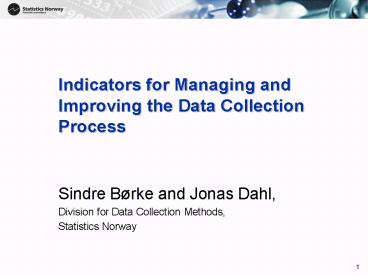Indicators for Managing and Improving the Data Collection Process
1 / 14
Title:
Indicators for Managing and Improving the Data Collection Process
Description:
Indicators for Managing and Improving the Data Collection Process Sindre B rke and Jonas Dahl, Division for Data Collection Methods, Statistics Norway –
Number of Views:69
Avg rating:3.0/5.0
Title: Indicators for Managing and Improving the Data Collection Process
1
Indicators for Managing and Improving the Data
Collection Process
- Sindre Børke and Jonas Dahl,
- Division for Data Collection Methods,
- Statistics Norway
2
Looking around
- Eurostat focus on quality issues through several
years - Statistics Norway
- Quality Issues at Statistics Norway
- Systematic Quality Work in official Statistics
Theory and Practice - FOSS A Standardisation Programme
- Development of standardised working prosesses,
methods and systems - A system for systematic quality measurements and
control - Organisation and human resource development
supporting this
3
Defining a Project
- Information for Different Levels of Management
- Continuous Quality Improvement
- Part of the Statistical Value Chain
- Questionnaire-based Data Collection, and Editing
on Micro Level - Limited Number of Indicators
4
Indicators
- Specific and measurable elements of statistical
practice - Defined by parameters
- Representative for the component it indicates
- Easy to interpret
- (Easy to collect data)
5
Indicators definitions
6
Groups of Indicators
- Illuminating stages in the value chain
- choice of instrument(s) and designing
questionnaires - respondent behaviour (incl use of
support-telephone and e-mail) - progress in data collection (effect from
reminders etc) - non-response
- the merging of data in multi-mode design surveys
- controls and corrections
7
Sick leave questionnaire respondents telephone
calls
8
Groups of Questionnaires
- Not all indicators are relevant on all
questionnaires - Use of indicators means comparing
- Clustering of questionnaires to create meaningful
comparisons (benchmarking) - Year, Quarter or Month
- Business or Huseholds/Persons
- Interview/selfadministration
- .
9
Response rates development over time
10
Recurrent surveys
- Comparisons/development over time
- Expected results of changes in questionnaire or
process - Stability in processes
11
Hotel statistics questionnaire Electronic Data
Delivery
12
Summing up
- No standards set, but observing level in each
indicator - Following recurrent surveys over time,
identifying changes - Benchmarking comparable surveys
13
Experiences so far
- Split up is necessary to establish relevance
- Small steps on the value chain
- Groups of comparable questionnaires
- Criterias for clustering are not established
- Some interesting indicators will be difficult
(expensive) to establish - Project challenge to keep focus on definitions,
leaving the interpretation and action to others
14
The near future in the project
- Reformulating targets and ambitions
- Some more results in demo-version
- Defining indicators
- Clusering questionnaires
- Data collection design for defined parameters
(implementing project results)































